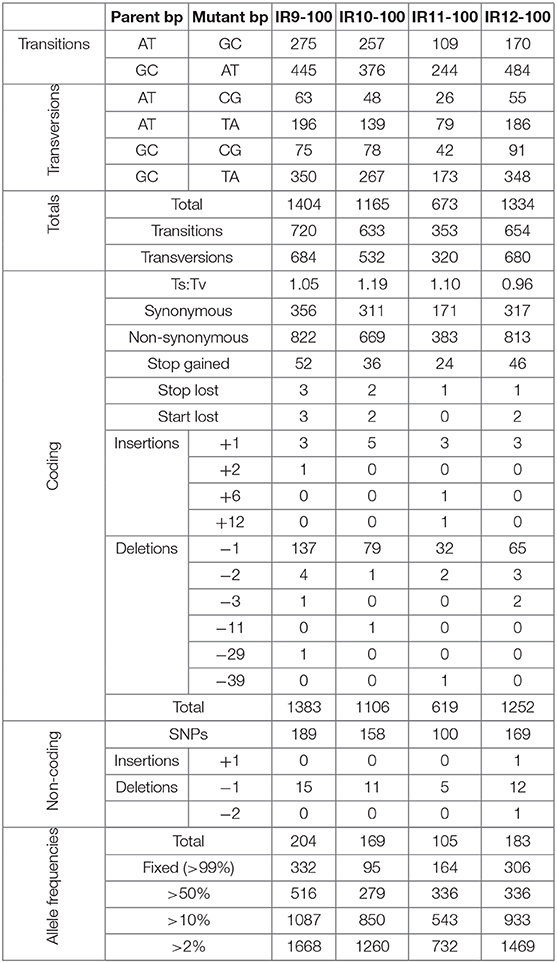Physiology of Highly Radioresistant Escherichia coli After Experimental Evolution for 100 Cycles of Selection
- 1Department of Biochemistry, University of Wisconsin-Madison, Madison, WI, United States
- 2DOE Joint Genome Institute, Berkeley, CA, United States
- 3Center for Genomic Science Innovation, University of Wisconsin School of Medicine and Public Health, Madison, WI, United States
- 4Department of Systems Biology, Harvard Medical School, Boston, MA, United States
A Corrigendum on
Physiology of Highly Radioresistant Escherichia coli After Experimental Evolution for 100 Cycles of Selection
by Bruckbauer, S. T., Martin, J., Minkoff, B. B., Veling, M. T., Lancaster, I., Liu, J., et al. (2020) Front. Microbiol. 11:582590. doi: 10.3389/fmicb.2020.582590
In the original article, there was a mistake in Table 1 as published. Three rows in Table 1 were inadvertently labeled incorrectly. The rows are in the “Transversions” category as follows: GC to TA, AT to TA, and GC to CG. We have re-labeled these rows so that these data under each population heading now reflects the correct number of each mutation type (in order, these rows are now AT to TA, GC to CG, and GC to TA). The corrected Table 1 appears below.
The authors apologize for this error and state that this does not change the scientific conclusions of the article in any way. The original article has been updated.
Keywords: ionizing radiation, experimental evolution, reactive oxygen species, double-strand breaks, DNA Repair, Escherichia coli, Deinococcus radiodurans
Citation: Bruckbauer ST, Martin J, Minkoff BB, Veling MT, Lancaster I, Liu J, Trimarco JD, Bushnell B, Lipzen A, Wood EA, Sussman MR, Pennacchio C and Cox MM (2020) Corrigendum: Physiology of Highly Radioresistant Escherichia coli After Experimental Evolution for 100 Cycles of Selection. Front. Microbiol. 11:617806. doi: 10.3389/fmicb.2020.617806
Received: 15 October 2020; Accepted: 05 November 2020;
Published: 11 December 2020.
Edited and reviewed by: Vasco Ariston De Carvalho Azevedo, Federal University of Minas Gerais, Brazil
Copyright © 2020 Bruckbauer, Martin, Minkoff, Veling, Lancaster, Liu, Trimarco, Bushnell, Lipzen, Wood, Sussman, Pennacchio and Cox. This is an open-access article distributed under the terms of the Creative Commons Attribution License (CC BY). The use, distribution or reproduction in other forums is permitted, provided the original author(s) and the copyright owner(s) are credited and that the original publication in this journal is cited, in accordance with accepted academic practice. No use, distribution or reproduction is permitted which does not comply with these terms.
*Correspondence: Michael M. Cox, cox@biochem.wisc.edu
†Present address: Joseph D. Trimarco, Department of Molecular Genetics and Microbiology, Duke University School of Medicine, Durham, NC, United States
 Steven T. Bruckbauer
Steven T. Bruckbauer Joel Martin
Joel Martin Benjamin B. Minkoff
Benjamin B. Minkoff Mike T. Veling4
Mike T. Veling4 Brian Bushnell
Brian Bushnell Michael R. Sussman
Michael R. Sussman Michael M. Cox
Michael M. Cox